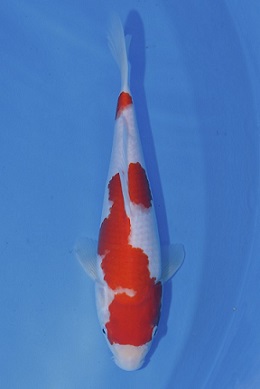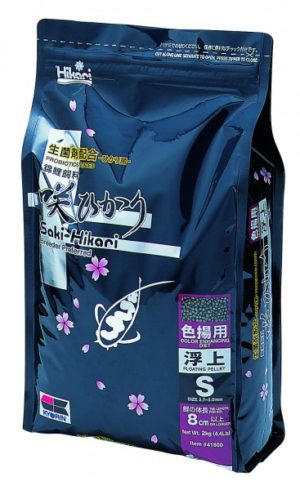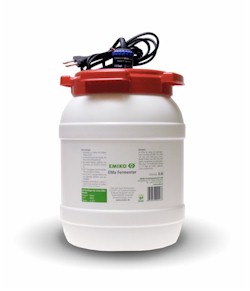FOR THE KOI HOBBYIST January 2003 by Sandra Yosha, DVM, PhD KHV Disease
KHV is the most deadly, economically important disease threatening koi
in the United States in 2003.
The time interval between exposure and onset of KHV disease is temperature
dependent; the lower the temperature, the longer the incubation period
(time between a first exposure to the virus and the onset of disease).
KHV seems to survive at low temperatures better than high temperatures
(> 86° F), but disease caused by KHV is generally seen between 68-85° F.
Koi that have been exposed to KHV have 4 possible fates:
a) are not infected, i.e., are naturally resistant or are immune
b) are infected and die or
c) are infected, but survive and eliminate the virus or
d) are infected and survive, but become asymptomatic carriers.
Asymptomatic carriers are healthy
animals that have viral DNA somewhere on or in their body (the site
remains to be determined) and when the right conditions (which are not
completely known) occur, the viral DNA becomes activated and begins to
reproduce more viruses. The conditions under which the virus is
eliminated or becomes latent (inactive) is still unknown. Carrier fish
contain viral DNA that can become active some time in the future and
can spread the infection to previously unexposed fish.
Stress
(including transport, parasites, poor water quality and other factors)
probably plays a role in causing fish to breakdown from the disease;
KHV is often associated with secondary diseases (i.e. Costia).
The virus attacks epithelial cells of the koi, especially skin and gills.
This results in excessive mucus shedding, dry feeling skin, dead gill
cells (often attacked by fungus, parasites and bacteria). Affected koi
do not eat, cannot breathe, and die a slow, painful death, often
lasting weeks.
The mortality rates of populations of koi from a pond in which symptomatic koi were diagnosed (confirmed by laboratory analysis) range from 50-100%.
There is clinical evidence that suggests that KHV affects koi, but not
goldfish, but it is not known whether or not goldfish can harbor live
virus, and if so, for how long.
Diagnosis of KHV
The most effective way to diagnose KHV at the present time
in sick fish is by the PCR test for KHV DNA.
Virus Isolation and histology (stained slides interpreted by experts)
is also possible, but takes longer. Each test has pitfalls, and is only
as reliable as the sampling method and interpretation. All of the tests
are subject to false negatives; the PCR test can have a false positive
results. Histology is not specific for KHV. Accuracy is critical and
sometimes multiple tests must be run. This diagnosis is too important
to trust to inexperienced hands.
Current tests are not useful in finding KHV in healthy carrier fish.
However, directly exposing KHV free koi to healthy suspected carrier
fish (at temperatures between 68-80°) might cause disease in the KHV
free koi within a few weeks (or up to 3 months), which can be tested
for KHV. The technique is not failsafe. However, since there is no
reliable laboratory method of detecting carriers by any other means,
this method could be tried. Obviously, a test that does not cost of
lives of innocent koi would be welcome.
Treatment of KHV Disease
There is no cure or treatment for KHV viral infection at this time.
Treatments (chloramine T or potassium permanganate treatment for
secondary bacterial gill disease, fungal and parasite control;
antibiotic treatment for internal secondary bacterial infections; salt
for relief of overhydration; vitamin C for immune support), might help
koi overcome secondary problems, but they should not be interpreted to
mean than they cure KHV disease. There is no cure. At temperatures <
65 ° F, koi generally do not die or show symptoms of KHV infection, but
infected fish will develop signs of KHV disease when the temperature
reaches optimum for this virus (68-80°). Raising the temperature to
> 86° F might increase the number of survivors. There are still no
documented scientific reports to establish reliable treatment
guidelines at this time, but chloramine T or potassium permanganate
treatments may also be beneficial by reducing the number of live
viruses in the water. Sick fish might not survive the treatments;
surviving fish might have permanent injuries. Treatment can be costly.
Individually valuable and privately owned fish might be worth the
effort, but it is not cost effective for most dealers. Furthermore,
surviving koi must be considered to be carriers until proven otherwise,
and therefore, should not be shown, sold, or transferred without
advising the new owners that these are KHV survivors.
Prevention of KHV Exposure
It is highly recommended that owners quarantine all new and any returning
(i.e., having been outside the system) fish at the owner’s home. There
is good evidence to assume that all koi have been exposed to
one or more disease causing agents, and that through proper care and
management, the losses of koi to disease can be greatly reduced.
However, unlike other infectious diseases that can be cured or treated
effectively, viruses are incurable, and KHV is associated with high
mortalities and permanent carrier fish.
Therefore, quarantine is the best defense against KHV at this time.
There is good reason to recommend English style koi shows and advise
against Japanese style koi shows.
Field cases of KHV had a common factor: koi had been in direct contact
with other koi (newly purchased, or recently shown in a Japanese style
koi show) and then entered a pond without quarantine. Recently
transported fish are stressed (which is believed to be underlying
facilitator of KHV disease) and koi are moved more often in a Japanese
style koi show. KHV is suspected to be present in koi populations from
many countries, and current evidence suggests that no county of origin
should be considered free of the virus. There seems to be no
justification for showing koi in Japanese style koi shows where the
fish are in direct contact with many koi from many places. While the
tradition and beauty of a Japanese style koi show would be missed by
many, preserving tradition is not worth the potential risk of harming
all of the beautiful animals that the show was designed to appreciate
and honor. Since koi are truly domestic animals and often loved pets,
we owe it to them to protect their health.
There is little documented information about how KHV is transmitted (i.e. by
water, direct contact with infected fish, through an intermediate host
etc) or about how long, and under what conditions the virus will live
away from the host. The virus may be transmitted by water or nets
(short term and minimal contact),
but disease outbreaks are definitely linked to direct fish to fish contact..
Herpes viruses are killed by routine disinfection, so KHV is assumed to
be likewise susceptible. Therefore, a good disinfection procedure that
is used regularly and correctly is an essential part of a disease
prevention program.
– Be an educated hobbyist.
Quarantine your fish. Ask your dealer about their quarantine and
disease control practices, and work with dealers who quarantine and
have routine established veterinary care. Each inspection, quarantine
and disease prevention program reduces the risk of KHV. Watch for
updates about the virus and control measures such as vaccinated fish,
resistant fish or populations of KHV free fish, which might become
available in the near future. Attend seminars about KHV or work with
qualified professionals who are up to date on this disease. If KHV is
suspected, get professional help.
This disease is too deadly to be missed and too costly to be wrong.
The best way to control KHV is by having breeders, dealers,
veterinarians, researchers and hobbyists working together so that the
hobby remains fun for all.
A QUARANTINE PROTOCOL FOR KOI HOBBYISTS TO REDUCE THE RISK OF KOI HERPES VIRUS (KHV) INFECTION
Quarantine alone will not prevent the spread of KHV, but it will reduce the risk
Quarantine, when used as part of a comprehensive disease prevention
program, is the single best current method of preventing many different
types of infectious diseases from entering a koi pond. The following
quarantine protocol represents current thinking and experience of
several knowledgeable experts in the scientific, veterinary and hobby
community and will likely uncover most KHV infected koi. It is not
failsafe, and all koi owners are strongly advised to seek professional
advice when dealing with this disease. However, it is a very important
first step in reducing the risk of introducing KHV into a pond.
System requirements
Quarantine is forced isolation. Therefore, a suitable place for this isolation
needs to be prepared. Excellent conditions and good water quality is
essential because no quarantine is better that quarantine in a system that has poor conditions.
Details of how to build several different quarantine systems will be given the May/June ’03 issue ofKoiUSA.
The quarantine system needs to:
-Be adequate in size and shape – round is better than square
-Be free of initial pathogens — sanitize the system prior to use, or use a system known to be disease free.
-Be in a safe place – the environment should be tranquil and not subject to extremes
-Have a working bio filter – nearly a must and a definite advantage –
otherwise daily water changes and ammonia binders are required.
-Have the capacity to heat the water to 70- 75 degrees F.
-Be located a sufficient distance or have barriers such that other areas
are not easily contaminated by water or equipment used in and/or around
the system.
-Have adequate disinfection – see separate disinfection section.
-If the ‚heat method‘ is intended to be employed in an attempt to increase
survivors ofKHV, provisions to heat the tank water to 86° F need to be
available.
The protocol
Under ideal conditions, the water in the quarantine tank water should be the
same temperature and pH as the water in which the koi has been swimming
over the last couple of weeks. If this is not possible, then try to get
as close to temperature as practical remembering that koi tolerate a
rise in water temperature better than a drop.
The koi to be isolated should be contained in a transport bag with adequate
water and oxygen and floated in the isolation tank water for 20 to 30
minutes to allow for temperature equilibrium between the water in the
bag and in the tank.
Fish
(but not transport water) should be released into a properly sized
container (koi tub) of clean quarantine tank water and subsequently the
fish should be quickly transferred to the tank. If the hobbyist is not
competent to handle the fish with bare hands, the transport bag should
be used to transfer the koi and should contain as little water as
possible, the goal being to minimize the amount of transport water put
into the quarantine tank.
The fish should be kept quiet and under cover of Styrofoam or pvc pipes
The temperature of the water in the Q-tank should be adjusted and held
between 70° to 75° F for a period of no less than three weeks. During
the temperature adjustment period, the temperature should not drop or
raise more than 5° F per day.
Do not feed the koi for the first few days. Then, if the fish appear hungry,
start feeding a little twice per day.
Over the entire period of quarantine, be sure to monitor water parameters,
particularly ammonia, nitrite, pH alkalinity, and temperature and make
any necessary adjustments and/or take appropriate measures.
Water changes are usually beneficial, are recommended and a minimum of 10%
per day is advisable. Always dechlorinate new water used for water
changes and use an ammonia binder if the water contains chloramines and
you are changing over 20% or if you do not have a working bio-converter
on the system.
The fish should be maintained at 70° to 75° F for no less than three weeks
and a much better period would be three months.
The longer the quarantine period, the more likely infected fish will be revealed.
At some time during the quarantine period, a fish of „lesser desirability“
from your pond should be placed in the tank with the new arrival(s).
Koi are social animals, and need companions. However, if there are more
than one koi in quarantine, the pond fish can be added after 1-3 weeks
in quarantine, and the population kept for 3 weeks to 3 months more. By
waiting until 3 weeks, many diseases, including KHV will become
obvious, and can be eliminated before any pond fish are at risk.
During the period of quarantine, periodically check (or have a professional
check) for any other abnormal or disease conditions. It is advisable to
have a complete and accurate diagnosis of conditions found in
quarantine, make sure that the quarantine system has good water quality
and follow expert advice for keeping koi healthy. Monitor the tank
daily and if any fish (new or old) shows the symptoms typical of KHV,
call a qualified veterinarian to take samples and submit them to a
qualified lab for testing. For a list of qualified veterinarians, see
the AKCA web site at: www.akca.org and follow the „KHA“ link
then the „Referral Veterinarians“ link. If maintained at the 70° to 75°
F temperature with no attempt to otherwise support the fish or suppress
opportunistic pathogens, about 10% of the fish should be expected to
survive.
KHV
infected koi may be euthanized (humanely killed) and disposed of
properly to prevent spread, or an attempt may be made to save the fish.
One method reported successful in saving a substantial percentage of
KHV infected koi is to elevate the temperature of the tank water to 86°
F until the fish recovers. Others (see previous section) involve adding
chemicals to the water to treat the symptoms of sick fish and possibly
to prevent transmission of virus. Remember there is no cure for KHV.
DISINFECTION
Using separate equipment for separate systems is best but when that is not
possible or practical or if disease has invaded a system and ponds and
equipment need to be disinfected, the following should prove helpful.
Household bleach, a sodium hypochlorite solution (usually 5.25%), is a good
disinfectant particularly for ponds (without fish) and for infrequent
or once-off disinfecting of lager equipment. The recommended
concentrations are 200 ppm (-145 ml or 5 oz per 10 gallons) for one
hour and 10 ppm (-725 ml or 3 cups per 1,000 gallons) for 24 hours‘.
Bleach is toxic to fish but can be neutralized with sodium thiosulfate
(„STS“ – a dechlorinator). Use STS at the rate of 1 gram per 10 liters
of water‘ (-380 grams or 0.81 pounds per 1,000 gallons of water) to
neutralize sodium hypochlorite at 200 ppm. Bleach can quickly degrade
nets and other equipment. A material that is much gentler on equipment
and good choice for general sanitizing of nets, tubs and smaller
equipment is benzalkonium chloride („BZK“), a quaternary ammonium
chloride compound.
For some years, many koi shows have used BZK to disinfect equipment. The
typical dose used there is about 200 ppm. That dosing was chosen
because it is effective against many pathogens and is not lethal to koi
in short term dips of that concentration. If the risk of accidentally
placing koi in a disinfecting tank is small, a higher concentration can
be used to provide faster action, i.e., 250 to 500 ppm for 20 to 30
minutes‘ or 1000 ppm for one minute2 .If 50% BZK is
purchased, a disinfecting solution of-400 ppm may be prepared by
placing 3.0 ml of 50% BZK in each gallon of water. To avoid large
amounts of foam, the BZK concentrate should be added to the water and
not vice versa. Containers for dipping equipment should be large enough
to handle any and all equipment anticipated to need disinfecting. If
there is a risk of significant contaminants entering the dipping
container, care should be taken to cover the container when not in use.
BZK is available in a 50% solution from Argent Labs. Western Quat
(quaternary ammonium chloride, -10% solution) is available from Aquatic
Eco-Systems. Or, see your local veterinarian for specific uses and
disinfection protocols. Disinfection does not work if not used
properly; it works best when used as part of a comprehensive disease
prevention program.
Equipment that is dirty or has organics on its surface should be thoroughly
cleaned prior to disinfecting as contaminants can protect pathogens
from the disinfectants and organics tend to combine with and „use up“
the active ingredients of disinfecting solutions or protect pathogens
from it.
Dispose of plants from infected KHV infected ponds.
Contributing authors:
Rob Hildreth, DVM
Aquatic Veterinary Services 4840 Irvine Blvd. #108 Irvine, CA.92620 (714) 838-3433 Thefishdoc@aol.com
Tim Miller-Morgan, DVM
Extension Veterinarian/Assistant Professor
Ornamental Aquaculture
Oregon Extension Sea Grant
College of Veterinary Medicine
Hatfield Marine Science Center
Oregon State University
Newport, Oregon
(541)574-6534 (voice)
(541)265-3 887 (fax)
(541)270-0223 (cell)
tim.miller-morgan@hmsc.orst.edu
Alien C. Riggs, DVM, MS
Aquatic Animal Health
Dept. of Large Animal Clinical Sciences
College of Veterinary Medicine
University of Florida
PO Box 100136
Gainesville, Florida 32610-0136
Telephone 352-392-4700 ext. 5686
Fax: 352-392-8289
Sandra Yosha, DVM, PhD
Private Practice and Consulting Veterinarian for the Koi Health Advisor Program of the AKCA Lakeland, FL Cell: 863-838-4282 dvm4fish@aol.com
‚ Herwig, N. „Handbook of Drugs and Chemicals Used in the Treatment of Fish Diseases“ Charles C. Thomas, 1979 2 Billard, R. „Carp, Biology and Culture“ Springer-Praxis, 1995


